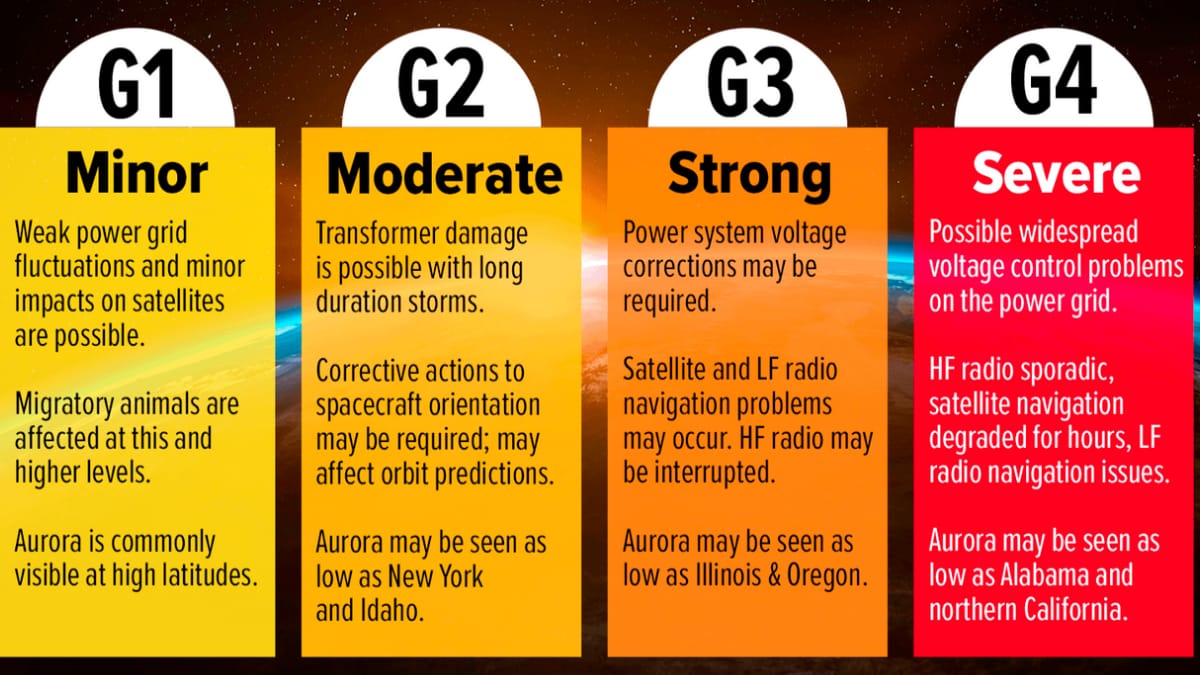Introduction:G4 Solar Storms Unleashed
Solar storms, captivating yet formidable natural phenomena, arise from disturbances on the Sun’s surface, releasing immense energy into space. These events, comprising solar flares and coronal mass ejections (CMEs), hold the potential to mesmerize with auroras while simultaneously posing threats to our technological infrastructure. Among these, the recent G4 solar storm has emerged as a notable event, captivating attention due to its unparalleled strength.
Solar storms, with their origins deeply rooted in the Sun’s dynamic behavior, offer a glimpse into the awe-inspiring forces governing our solar system. Spanning vast distances and affecting celestial bodies, these phenomena showcase the intricacies of our cosmic neighborhood. The recent G4 solar storm, a product of such solar tumult, epitomizes the raw power and unpredictability of nature’s cosmic ballet.
Understanding : Insights into Solar Dynamics
Central to comprehending the ramifications of the G4 solar storm is grasping the fundamentals of solar activity. The Sun operates on cyclical patterns, exhibiting periods of heightened activity marked by solar flares and CMEs occurring approximately every 11 years.

Solar flares, sudden eruptions of energy, emit radiation across the electromagnetic spectrum. Conversely, CMEs expel vast volumes of plasma and magnetic fields into space, with potential implications upon reaching Earth’s magnetosphere, manifesting as geomagnetic storms.
The G4 Solar Storm Unveiled: Unprecedented Impact
Distinguished as a G4 storm on the NOAA Space Weather Scale, the G4 solar storm signifies a severe geomagnetic disturbance capable of inducing widespread technological disruptions. Originating from a potent solar flare and subsequent CME, its trajectory toward Earth prompted meticulous monitoring and evaluation by scientists.
Anticipating Impact: Early Warnings and Mitigation Measure
In anticipation of the G4 solar storm’s arrival, early warnings were disseminated by space weather forecasters, thanks to advancements in solar observation technology and international cooperation in data sharing. These timely warnings enabled governments, emergency responders, and critical infrastructure operators to enact preparatory measures swiftly and effectively. Utilities, bolstered by improved grid resilience research, fortified power grids with surge protectors and redundancy measures. Satellite operators, leveraging real-time tracking and communication systems, adjusted spacecraft orientations to minimize exposure to harmful radiation.
Airlines, guided by enhanced space weather prediction models, rerouted flights away from areas of heightened auroral activity, protecting passengers and sensitive aircraft equipment. This concerted effort, facilitated by global communication networks and international collaboration plans, illustrated the power of preparedness in mitigating potential fallout and minimizing disruptions. This proactive approach, a testament to scientific progress and international cooperation, proved instrumental in mitigating the storm’s impact on vital systems, potentially saving billions in repair costs and economic losses.

Impact on Technology: Unveiling Vulnerabilities
Despite preparatory actions, the G4 solar storm precipitated significant disruptions across technology and communication systems globally. Satellite communications faltered under increased interference, while power grids grappled with geomagnetically induced currents, leading to voltage fluctuations and sporadic outages, underscoring the susceptibility of infrastructure to solar disturbances.
Astronomical Phenomena Amidst Chaos: The Beauty of Auroras
While solar storms impose technological challenges, they concurrently gift humanity with mesmerizing displays of natural wonder in the form of auroras. The G4 solar storm facilitated auroral sightings beyond customary latitudes, with vibrant hues illuminating the night sky, providing a celestial spectacle amidst terrestrial turmoil.
Lessons Forged and Pathways Ahead: Bolstering Resilience
The G4 solar storm serves as a pivotal juncture for reflection and action, spotlighting the imperative of enhancing resilience against solar activity-induced disruptions. Investment in advanced space weather forecasting, fortification of critical infrastructure, and fostering international collaboration emerge as imperative strategies for navigating future geomagnetic threats.
Conclusion: Charting a Resilient Course Amid Solar Turbulence
As humanity ventures forth amidst the celestial turbulence of solar storms, the G4 solar storm stands as a beacon, illuminating pathways toward resilience and preparedness. By heeding the lessons unearthed from this event and fostering collective action, we can navigate the solar storms ahead, safeguarding our technological infrastructure and advancing towards a more resilient future. Through sustained commitment to research, innovation, and international cooperation, we can forge a future where the wonders of space coexist harmoniously with the resilience of human civilization.



